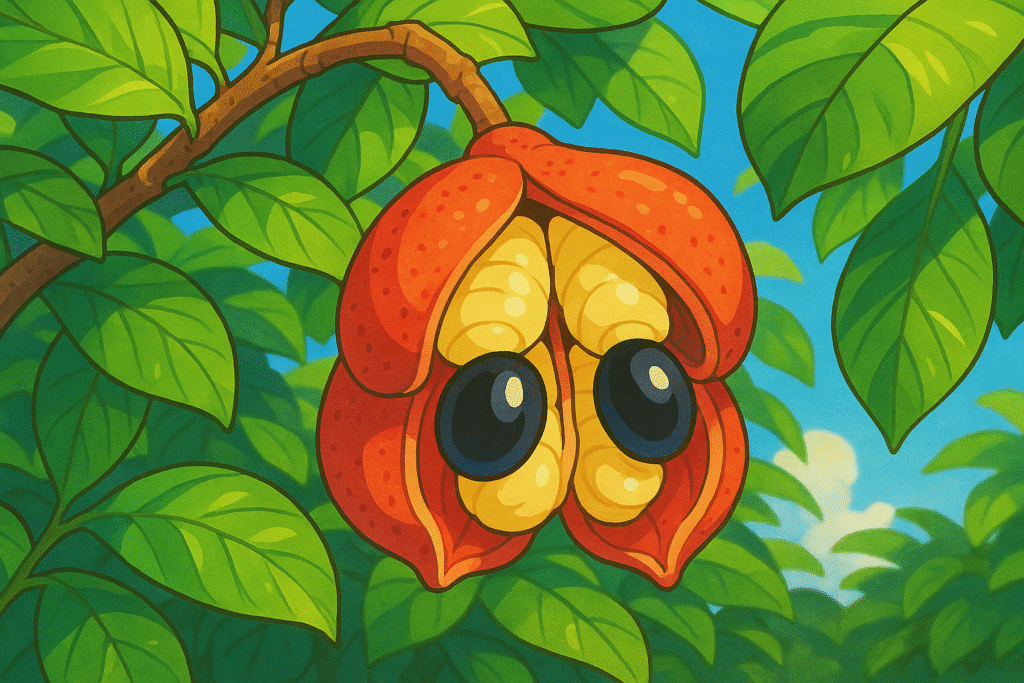Ackee (Blighia sapida)

About Ackee
Ackee is a tropical fruit that’s as controversial as it is delicious. Native to West Africa but best known as the national fruit of Jamaica, ackee (pronounced ah-kee) has a creamy, buttery texture and a mild, nutty flavor that pairs surprisingly well with savory dishes. It’s most famously cooked with saltfish — a cornerstone of Jamaican cuisine.
What makes ackee stand out isn’t just its taste, but its science and symbolism. It looks like a botanical brain when opened, and it literally must be open before it’s eaten — more on that soon. Whether you’re exploring Caribbean cooking or just want to taste something completely different, ackee offers a gateway into a deeper culinary tradition.
The History of Ackee
Ackee’s journey starts in West Africa, likely Ghana, where it was valued for both its food and medicinal properties. It traveled across the Atlantic during the 18th century, possibly aboard slave ships, and took root — quite literally — in Jamaica.
There, ackee flourished, both agriculturally and culturally. It became a key part of the Jamaican identity, with “ackee and saltfish” eventually declared the national dish. Over time, it evolved from a foreign import into a symbol of Jamaican pride, survival, and creative food culture.
But ackee’s story isn’t without complexity. Its arrival is tied to painful histories of slavery and colonization. And yet, like so many diasporic ingredients, ackee was embraced and transformed — becoming something uniquely Caribbean.
The Science of Ackee
Ackee is famously tricky — it contains a toxin called hypoglycin A, which can cause what’s known as “Jamaican vomiting sickness” if eaten unripe. That’s why you should never pick a closed ackee. Only the naturally opened fruit is safe — a fascinating example of nature’s own safety signal.
Once open and properly prepared, the creamy yellow arils (the edible part) are entirely safe. Their smooth texture and rich flavor come from high levels of fatty acids, especially linoleic and oleic acid — similar to what you’d find in avocados.
The fruit’s signature look — bright red pod, yellow lobes, and jet-black seeds — is the result of its unique development as a member of the Sapindaceae family, related to lychee and longan.
The Geography of Ackee
Though native to West Africa, ackee is now most closely associated with Jamaica, where the tree grows abundantly in warm, humid conditions with well-drained soil. You’ll find it in home gardens, roadsides, and local markets — especially in rural parishes.
Outside the Caribbean, ackee can be grown in similar tropical and subtropical climates like southern Florida, parts of Central America, and some Pacific islands. However, due to its toxicity risks when harvested unripe, it’s tightly regulated in many countries.
Canned ackee, cooked and exported from Jamaica, is the safest and most common way to experience the fruit abroad — though purists argue nothing beats fresh, sun-ripened ackee straight from the pod.
FAQs All your questions about Ackee: answered
Is ackee safe to eat?
Yes — but only when ripe. The pods must open naturally on the tree before harvesting. Never eat unripe or unopened ackee, as it contains dangerous toxins.
What does ackee taste like?
It’s often compared to scrambled eggs or soft cheese. The flavor is mild, buttery, and slightly nutty — more about texture than bold flavor.
Can you eat ackee raw?
No. Even ripe ackee must be boiled before eating to remove any residual toxins. Never consume raw ackee.
Is ackee a fruit or a vegetable?
Botanically, it’s a fruit. But in Jamaican cuisine, it’s treated like a vegetable and used in savory dishes.
Where can I buy ackee?
Outside the Caribbean, look for canned ackee in West Indian grocery stores or specialty food markets. Fresh ackee is rare due to export restrictions.